 OML introduces millimeter wave (mm-wave) intermodulation distortion (IMD) measurements to target emerging gigabit applications such as WirelessHD, WiGig, 802.11ad and E-band point-to-point radios. In these applications, the linearity of amplifiers and transceivers can adversely affect bit error rate, especially those involving higher order modulation. Due to waveguide constraints, IMD has been nearly non-existent on the millimeter wave frontier until now. For the first time, OML can thoroughly characterize mm-wave devices for S-parameters, gain compression and IMD.
OML introduces millimeter wave (mm-wave) intermodulation distortion (IMD) measurements to target emerging gigabit applications such as WirelessHD, WiGig, 802.11ad and E-band point-to-point radios. In these applications, the linearity of amplifiers and transceivers can adversely affect bit error rate, especially those involving higher order modulation. Due to waveguide constraints, IMD has been nearly non-existent on the millimeter wave frontier until now. For the first time, OML can thoroughly characterize mm-wave devices for S-parameters, gain compression and IMD.
Check out the following three introductory YouTube videos for a virtual demonstration:
- Direct-Connect: http://youtu.be/2LxmFgVZKGI
- Part 1 (N5262A): http://youtu.be/iGnAotIma8I
- Part 2 (N5262A): http://youtu.be/nkUIA-mS50Q
IMD is an industry standard technique that reveals the linearity of an amplifier using a two-tone measurement. With optional IMD, the standard VNA module adds a source module and coupler for handling the two-tone prerequisite. The main tone functions to characterize S-parameters and gain compression while the new second tone is easily available for IMD measurements. The two-tones and their IMD products reveal the linearity of the device: smaller products correspond to better linearity. Engineers can also calculate the third order intercept (TOI) for third, fifth, seventh and ninth order products.
Adoption of emerging amplifiers depends on cost. By combining measurement capabilities, OML addresses emerging requirements for single connection workflow (e.g., on-wafer) that can also reduce manufacturing cost. The VNA modules from OML are universally compatible with modern vector network analyzers from Rohde & Schwarz, Anritsu and Keysight. OML offers mechanical compatibility with existing probe stations, including the flexibility to upgrade existing VNA modules with IMD capabilities.
For more information, download our new VNA module brochure and new IMD application note, which includes an explanation of our IMD architecture along with example measurements:

